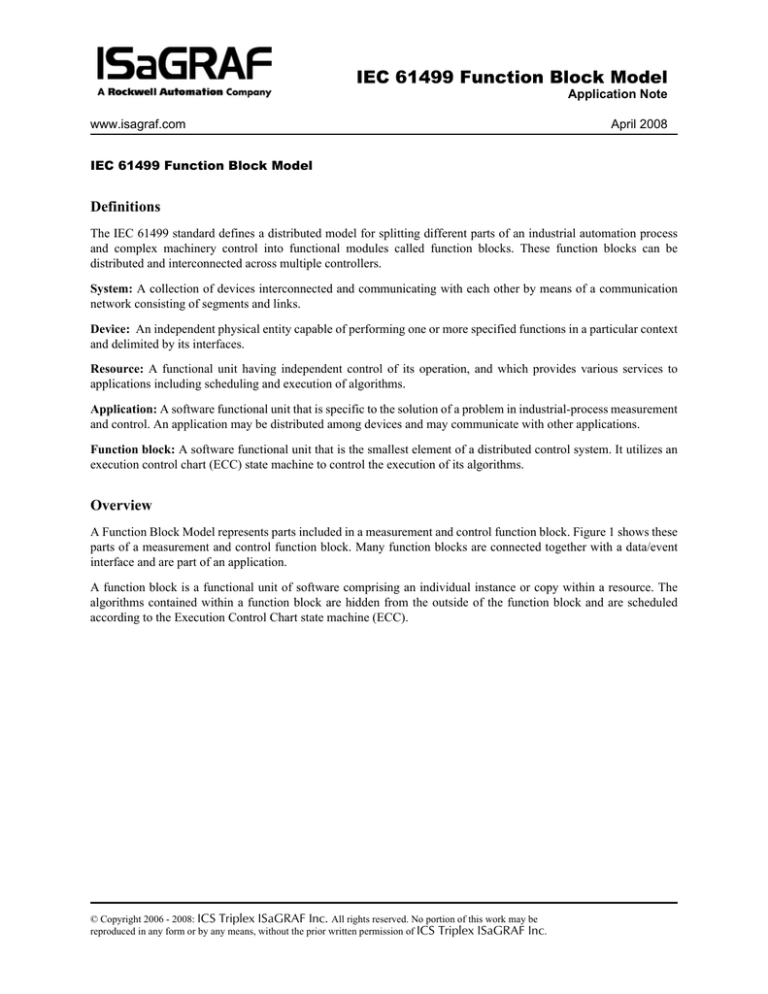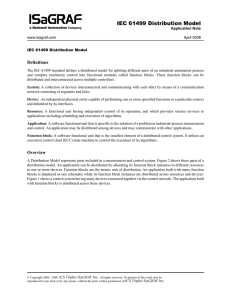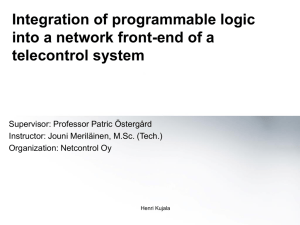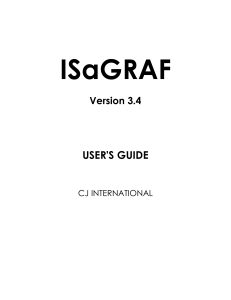
IEC 61499 Function Block Model
Application Note
www.isagraf.com
April 2008
IEC 61499 Function Block Model
IEC 61499 Function Block Model
Definitions
The IEC 61499 standard defines a distributed model for splitting different parts of an industrial automation process
and complex machinery control into functional modules called function blocks. These function blocks can be
distributed and interconnected across multiple controllers.
System: A collection of devices interconnected and communicating with each other by means of a communication
network consisting of segments and links.
Device: An independent physical entity capable of performing one or more specified functions in a particular context
and delimited by its interfaces.
Resource: A functional unit having independent control of its operation, and which provides various services to
applications including scheduling and execution of algorithms.
Application: A software functional unit that is specific to the solution of a problem in industrial-process measurement
and control. An application may be distributed among devices and may communicate with other applications.
Function block: A software functional unit that is the smallest element of a distributed control system. It utilizes an
execution control chart (ECC) state machine to control the execution of its algorithms.
Overview
A Function Block Model represents parts included in a measurement and control function block. Figure 1 shows these
parts of a measurement and control function block. Many function blocks are connected together with a data/event
interface and are part of an application.
A function block is a functional unit of software comprising an individual instance or copy within a resource. The
algorithms contained within a function block are hidden from the outside of the function block and are scheduled
according to the Execution Control Chart state machine (ECC).
© Copyright 2006 - 2008: ICS Triplex ISaGRAF Inc. All rights reserved. No portion of this work may be
reproduced in any form or by any means, without the prior written permission of ICS Triplex ISaGRAF Inc.
IEC 61499 Function Block Model
Figure 1: IEC 61499 Function Block Model
Event inputs and outputs are used to synchronize function blocks within an application and to schedule the algorithms
within the function block.
Data inputs and outputs are the interface with the external of the function block since internal data is hidden. The data
may be part of the algorithms and may also be state information for the Execution Control Chart (ECC).
Function blocks are created by defining their ECC and programming their algorithms. These function blocks are called
basic function blocks (see Figure 1). The ECC is a state machine processing events and scheduling algorithms. It
defines the behavior of the function block upon receiving events. The algorithms operate on internal variable values,
input values, and output values. Each basic function block can run on any resource.
When function block algorithms and the control of their execution are expressed entirely in terms of interconnected
function blocks, these are called composite function blocks (see Figure 2). These are created by interconnecting
existing basic and composite function blocks. No ECC or algorithm is created. A composite function block runs on
© Copyright 2006 - 2008: ICS Triplex ISaGRAF Inc. All rights reserved. No portion of this work may be
reproduced in any form or by any means, without the prior written permission of ICS Triplex ISaGRAF Inc.
2
IEC 61499 Function Block Model
any resource. However, the basic and composite function blocks making up a composite function block run on the
same resource as the main composite block.
Figure 2: Composite Function Block
An application is defined by function block (Basic and Composite) networks specifying event and data flows
throughout function block instances. The event flow determines the scheduling and execution of the function blocks’
algorithms. Each function block within the application can be distributed across resources and devices.
In ISaGRAF, an application can be created using custom function blocks or function blocks from libraries. Figure 3
shows the basic function block editor. Figure 4 shows the composite function block editor and figure 5 shows the
function block model displayed by the ISaGRAF toolset.
Figure 3 displays a function block ECC state machine and a function block algorithm from the basic function block
editor. The ECC is a state machine built using the SFC editor. Algorithms can use any of the IEC61131-3
programming languages as well as the flow chart language provided in the ISaGRAF toolset. The available IEC 611313 languages are the following: Sequential Flow Chart (SFC), Function Block Diagram (FBD), Ladder (LD),
Instruction List (IL), and Structured Text (ST).
Composite function blocks can also be created in the ISaGRAF toolset using the composite function block editor (see
Figure 4). ISaGRAF enables you to create a composite function block by adding any available basic and composite
function block to the function block network.
© Copyright 2006 - 2008: ICS Triplex ISaGRAF Inc. All rights reserved. No portion of this work may be
reproduced in any form or by any means, without the prior written permission of ICS Triplex ISaGRAF Inc.
3
IEC 61499 Function Block Model
The newly created function block is available for use in any application and can be configured to run on any resource
or device part of the system.
Figure 3: ISaGRAF Basic Function Block Editor
Figure 4: ISaGRAF Composite Function Block Editor
© Copyright 2006 - 2008: ICS Triplex ISaGRAF Inc. All rights reserved. No portion of this work may be
reproduced in any form or by any means, without the prior written permission of ICS Triplex ISaGRAF Inc.
4
IEC 61499 Function Block Model
Figure 5: ISaGRAF Function Block Model Viewer
References
International Electrotechnical Commission: Function Blocks Part 1 - Architecture (61499-1 © CEI:200X).
ICS Triplex ISaGRAF Inc.: ISaGRAF User’s Guide. November 2005.
© Copyright 2006 - 2008: ICS Triplex ISaGRAF Inc. All rights reserved. No portion of this work may be
reproduced in any form or by any means, without the prior written permission of ICS Triplex ISaGRAF Inc.
5




